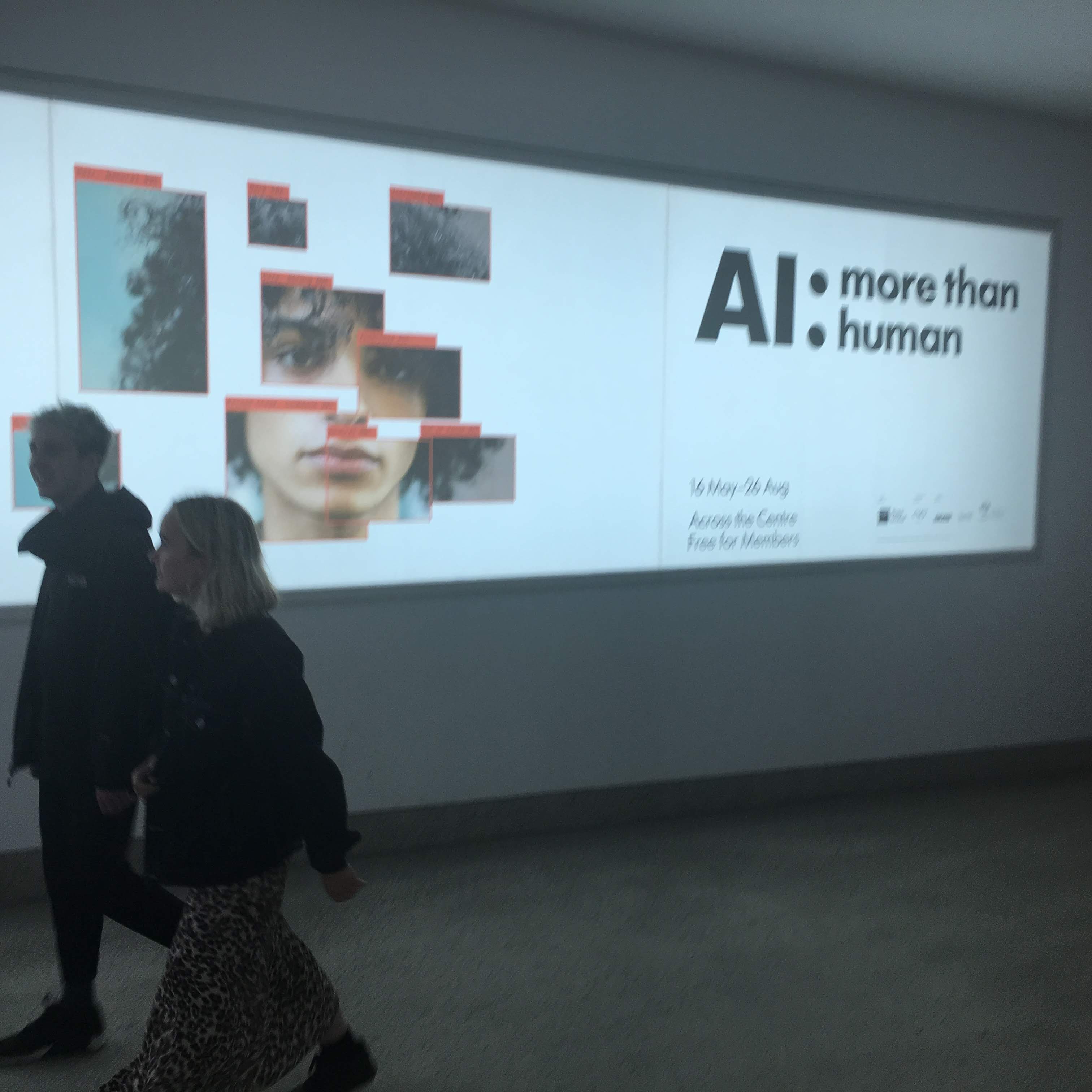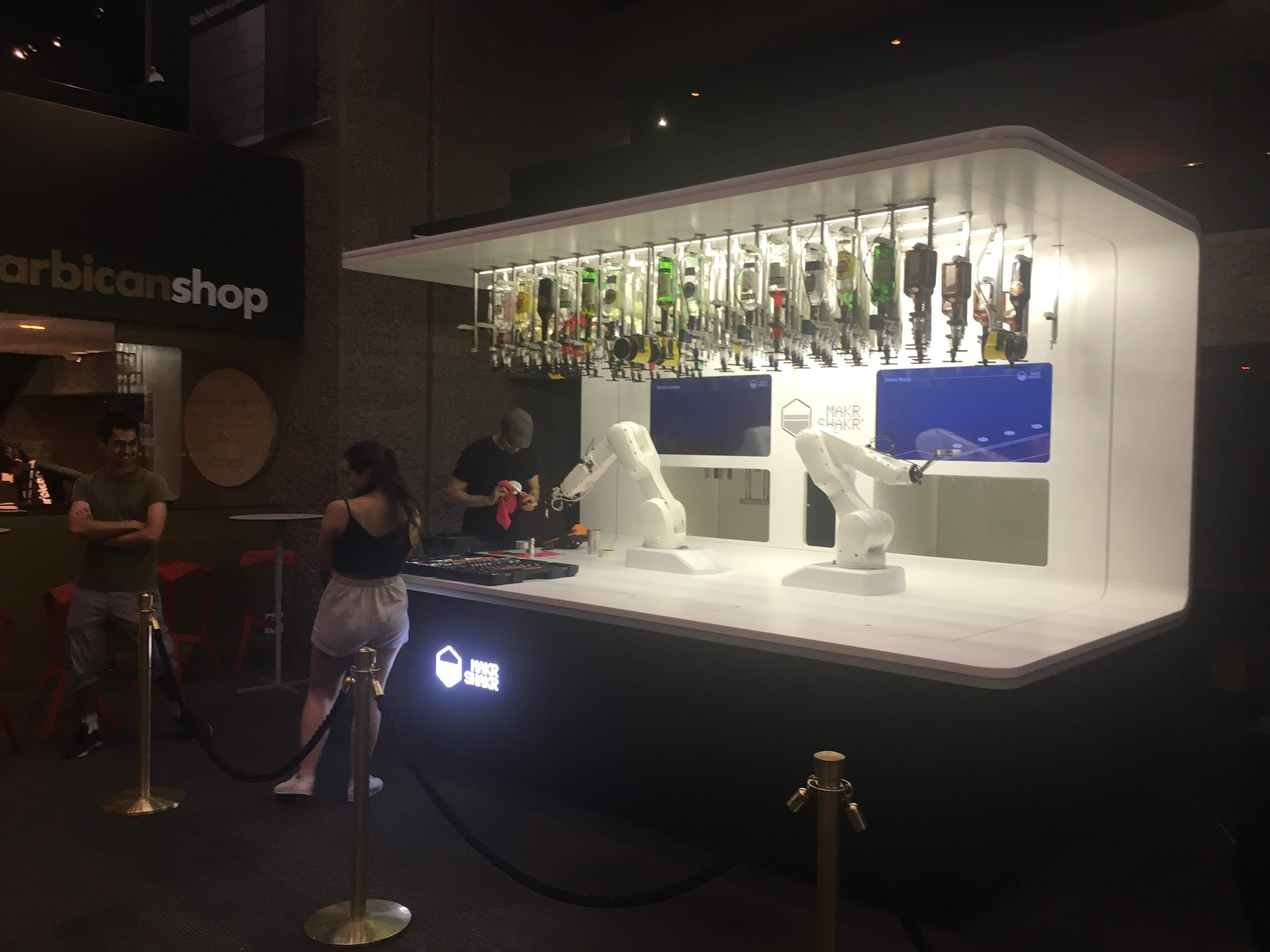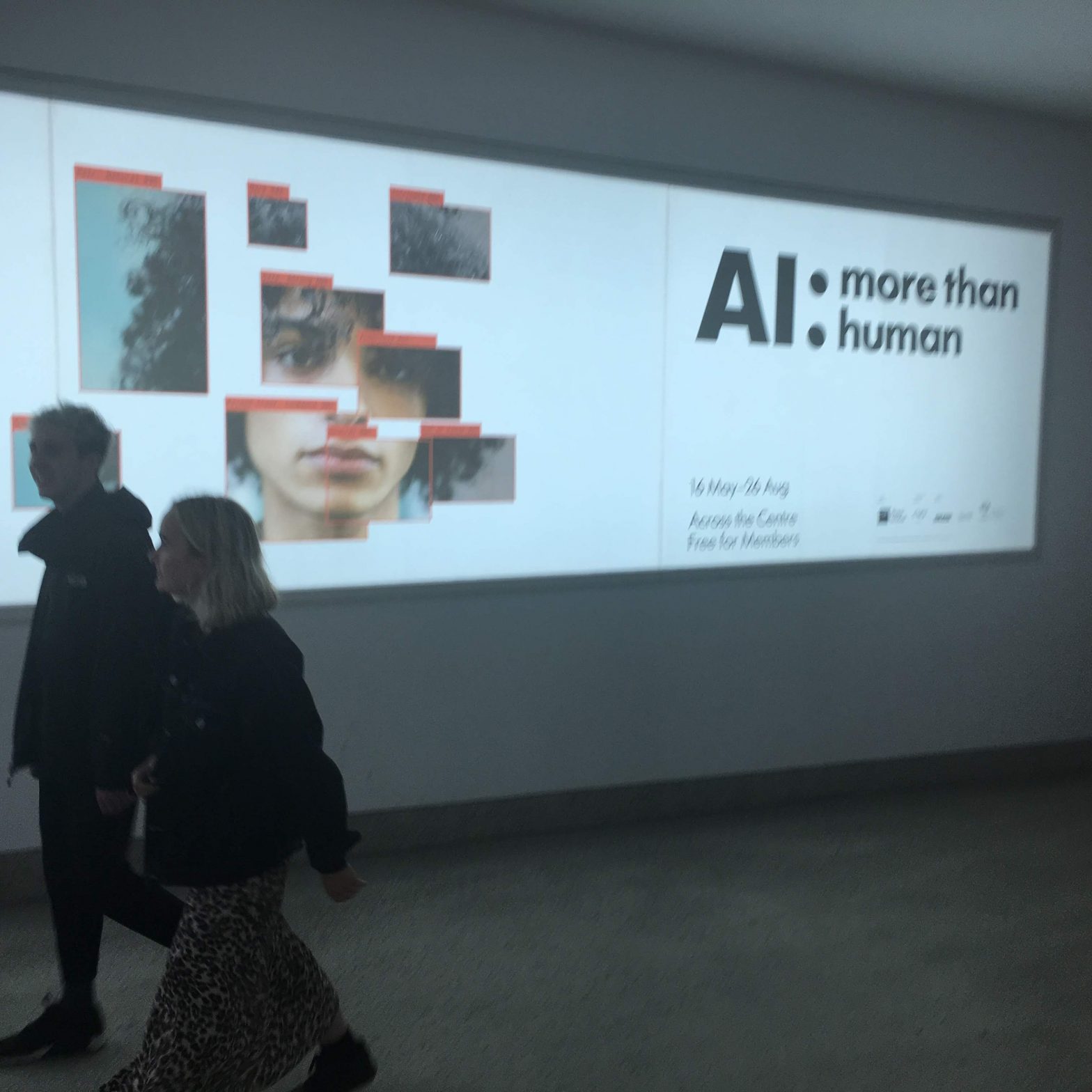16 May—Mon 26 Aug 2019, Across the Barbican Centre
The AI: More than Human show was the second major show on the past, present and future of the digital the Barbican has put on in the last decade, the first being the 2014 ‘Digital Revolution’ show [Notes]. It is to its credit it has addressed these key developments more than any other institution in London, including the Science Museum.

The show was engagingly sold:
This major centre-wide ‘festival-style’ exhibition runs throughout the summer until 26 Aug, and explores creative and scientific developments in AI, demonstrating its potential to revolutionise our lives. Bringing together artists, scientists and researchers, this interactive exhibition offers an unprecedented survey of AI with which you are invited to engage head-on.
Experience the capabilities of AI in the form of cutting-edge research projects by DeepMind, Massachusetts Institute of Technology (MIT) and Neri Oxman; and interact directly with exhibits and installations from artists including Mario Klingemann, Massive Attack, Es Devlin and teamLab to experience the possibilities first-hand.
Prepare for your preconceptions of AI to be challenged by this timely exhibition, that reflects on how this technology impacts our very existence.
‘AI: More than Human’ was curated by Dr Suzanne Livingston and Maholo Uchida (who discuss the show in this Unpacking the themes video), advised by Natalia Fuchs and assisted by Anna Holsgrove. The core of the show was in the Curve gallery, as with the ‘Digital Revolution’, which is an odd but workable exhibition space which curves around the Barbican concert hall. The space was setup with much ‘furniture’ – designed by Es Devlin – primarily black drapes, very theatrical, to separate and structure the narrative.
Broadly the narrative went from early examples of human characteristics being endowed onto non-human objects – the Jewish concept of the Golem, Japanese shintoism – through the development of computing and the concept of ‘cybernetics’ – via a lovely digital pictorial timeline – through Alan Turing, Norbert Wiener, et al, to modern developments such as Deep Mind’s AlphaGo, which was extensively examined in a table-based element of the show.
Areas in which AI is being used were illustrated including in aiding people with disabilities; healthcare and diagnosis; understanding human vision; robotics and personality; sensing mood; chatbots addressing the classic Turing Test; moderating discussion on news sites (Using the New York Times as an example); visualising and deconstructing micro-organic structures; synthesising music; and other more esoteric applications.
There were a number of ‘interactive’ installations, which generally worked well, not least with kids, incuding the New York Times moderation tool and the mood sensing display. There was also an example of the new Sony Aibo (all lower case, this version) which was surprisingly compelling for a project with which we’re so familiar, and probably the most practically ‘useful’ example of AI in action.


As with the Digital Revolution show, there were a number of installations around the Barbican Centre, which works very well to engage people who might fight shy of going into an exhibition. This worked particularly well with the ‘Future You’ installation by Universal Everything in the entranceway, which visitors found easy to understand and the engage with. Also ‘What-a-Loving-and-Beautiful-World’ immersive installation by TeamLab in the Pit Theatre space worked well and was magical (see image in Tweet below). And ‘2065 (Barbican Edition)’ by Lawrence Lek, a number of spatial and related games installed in an arcade style with multiple monitors near the show exit.

Reflection
The show did a good job of putting the concept of artificial intelligence and, more broadly, ‘artificial life’ in a historical context and the examples shown were generally intriguing, not well known, and enlightening. It tended to suffer from the common issue of failing to clearly define AI – assuming it can be defined – and embracing everything allied to it, from digital computing to robotics. Though algorithms are often used as a shorthand for AI, for me the key development is creating tools which can improve themsevles and possibly create valuable new tools which we might never create.
It would have benefitted from more clearly showing what was unique and valuable about AI and where it should complement – rather than be used to attempt to replace – human intelligence (and I believe there was one piece, a manifesto, which did attempt this). One area the show particular it did well was clarifying the concept of cybernetics as ‘the study of society and technology’.
I would like to have seen AI presented in both a more social, economic and industry context. And a clear explaination of why it has come to the fore again now, better questioning the hype, examining what it means to be human and some are redefining this. The human achievement which AI represents was also underplayed – though tributes were paid to early pioneers – as were the ways in which we might use AI to transform industry, society, culture, and our personal lives.
More of an examination of how we are using AI now would have been valuable too, not least to address the old aphorism that ‘realising the potential of AI is 30 years away… and always will be’ (a timeline The Smithsonian still posits). For instance, one of the most common and enthusiastically embraced aspects of AI, voice-based interfaces, was almost wholly ignored; yet such interfaces are one of the most promising ways we might understand and interact with our tools.
Seeing more humanity in a show about replicating the key aspect of humanity would have been appropriate
There was a notable lack of real people in the context of the show and, while it was ostensibly about the future, seeing more humanity in a show about replicating the key aspect of humanity would have been appropriate.
An aspect which was largely ignored was whether AI could be creative [see my responses], though a related event (The Eternal Golden Braid) did ask that question. The challenge of who, or what, decides what is creative, or beautiful, is currently much discussed and very much unresolved.
Quite a few elements in the show were video and could be viewed online at any time, which is an advantage, and it might help visitors to be able to explore this material in advance of seeing the show. Much of the material is available on a specially curated Google Arts & Culture site, which includes reflective pieces by writers including Jamie Bartlett, James Bridle and Rebecca Coleman; and a number of valuable videos, including an interview with the curator, can be found in the ‘Explore’ section of the show site, including Alexandra Daisy Ginsberg on her project ‘Resurrecting the Sublime’, sound designer Yuri Suzuki on his project reimagining Raymond Scott’s electronic sequencer machine.
Related events
AI: More than Human was associated with the ‘Life Rewired’ initiative, which focused on a pop-up space for talks, performances, workshops, and residencies, programmed in partnership with the British Council and The Royal Society, and designed by architects Dyvik Kahlen. Events included The Eternal Golden Braid: Gödel Escher Bach, 9 Mar 2019, on whether ‘an algorithm could ever write music to rival Bach’, with mathematician Marcus du Sautoy, harpsichordist Mahan Esfahani and composer Robert Thomas, and featuring a pre-recorded interview with Douglas Hofstadter, whose eponymous book inspired the event; an Exhibition Introduction by curator Anna Holsgrove on 18 July 2019; a drop-in discussion, Curator Computer Creator, on 4 July 2019, asking whether ‘a tech-savvy museum that connects with modern times enrich the way we experience art’; and a post-show event, The AI will see you now, on 21 August 2019, on the ethics of AI-driven healthcare.
Documentation
Tweets
Tweets about the show can be found using the hashtag #MorethanHuman
Nico Macdonald on Twitter
To the last day of the ‘AI: More than Human’ (#MorethanHuman) show @BarbicanCentre with elements of the show around the Centre, and the main show in The Curve, which is where the Digital Revolution show was back in the day (and Rain Room) https://t.co/rYA5HIMKoZ
https://twitter.com/Nico_Macdonald/status/1188949875750293504?s=20
Articles and reviews
- Barbican to explore links between art and artificial intelligence, Financial Times
- Anna Holsgrove On Curating ‘AI: More Than Human’ At The Barbican, Something Curated, 6 Apr 2019
- AI At The Barbican: Not So Bright After All – Bill Thompson – Medium
- ‘I’ve seen more self-aware ants!’: More Than Human – review, Jonathan Jones, The Guardian, 15 May 2019
- The Barbican opens AI: More Than Human exhibition, review in Dezeen
- ‘More than human’: Wonders of AI on show in London, Phys.org
Future
‘AI: More than Human’ will be shown in Groningen, the Netherlands (Dec 2019 – May 2020); Liverpool, UK (Jul 2020 – Oct 2020); and Shenzhen, China (Dec 2020 – May 2021
Discussion
(Friends of) friends can comment on my post on the show on my Facebook post. Others’ comments welcomed below.

